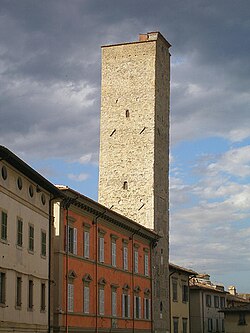Appearance
Città di Castello is a city in the north of Umbria in Italy.
Understand
[edit]Città di Castello is situated on a slope of the Apennines, and is the main town of the upper valley of the River Tiber. The city is mostly built of brick, since the local sandstone erodes very rapidly. At the beginning of the Iron Age the Etruscans settled in the valley, on the right side of the Tiber, and the Umbrians on the left.

Get in
[edit]Città di Castello is 56 km north of Perugia and 104 km south of Cesena on the S3bis. It is connected to the A1 highway by the SS 73 from Arezzo.
By train, Città di Castello is on the Terni – Sansepolcro line. Terni can be reached directly from Rome.
Get around
[edit]See
[edit]- Palazzo Comunale. The Council building (also called Palazzo dei Priori) is one of the most outstanding municipal sites in Umbria. It was built between 1322 and 1338. A grand sixteenth century staircase leads to the wide Council Hall, where some Roman ruins are conserved.
- Torre Comunale (Municipal Tower). The tower (XIII Century) is a symbol of Communal power which was also used on occasions as a jail. The tower is also known as "Torre del Vescovo" (Bishop's tower), because it joins Bishop's Palace. The top of the tower can be visited, with excellent views of the historical centre and the whole Upper Tiber Valley.
- Pinacoteca Comunale (Municipal Gallery). This is an art museum with mostly Renaissance works. It is notable for its external decoration by Giorgio Vasari and includes works by Luca Signorelli, Raffaello, Andrea and Giovanni Della Robbia, Ghiberti and Ghirlandaio. 10.00 - 13.00 and 14.30 - 18.30 Tuesday to Saturday; Sunday and holidays 10.00 - 18.30. Closed Monday. Entrance 5
- The Cathedral (Duomo). The cathedral, now mostly eighteenth century, has an altar-front of chased silver dating to the twelfth century. The Museo del Duomo, or cathedral museum, is famous for the Canoscio hoard, a set of Late Antique silver spoons and plates with Christian motifs.
- The Burri Collection. Alberto Burri was an Abstract Expressionist Painter who lived between 1915 and1995 and came from Città di Castello. The Fondazione Palazzo Albizzini "Collezione Burri", was instituted in 1978 by the painter himself. The Collection is housed in two museums. Palazzo Albizzini is an elegant Renaissance mansion of the second half of the XV century that houses works by Burri from between 1948 and 1989. The Ex Seccatoi del Tabacco (former tobacco dryers) was opened in 1990. In its 7,500 square meters it houses big cycles and sculptures produced between 1970 and 1993. A total of 257 works can be seen in the two museums. Tuesday to Saturday 9 -12,30 / 14.30 – 18.00. Sunday and Public Holidays 10.30 -12.30 / 15.00 – 17.00. Closed on Monday (when not public holiday), December 25th and January 1st. From November to March the former Tobacco Curing Barns are open only upon request, to be made at least 3 days in advance.
Do
[edit]Buy
[edit]Eat
[edit]Drink
[edit]Sleep
[edit]- La Preghiera in Calzolaro, Calzolaro (PG) 06018 Umbria. Located close to Umbertide, south of Città di Castello.
- Palazzo Terranova. Located in Ronti, about 7km west, in the hills overlooking Città di Castello, a luxury hotel in an old palace, with decor influenced by the 15th-century painter Piero della Francesca and named after operas. The La Traviata suite is supposed to be the best; the La Bohème Suite has large windows overlooking the valley; the Trovatore Suite enjoys a beautiful view of the setting sun. $$$$.

